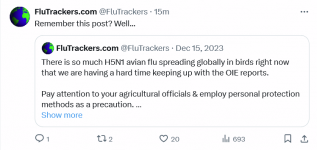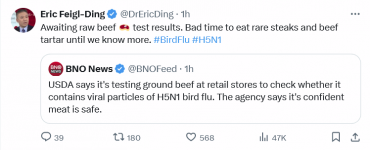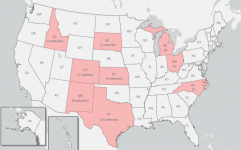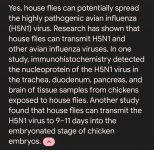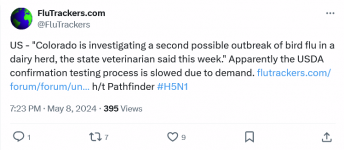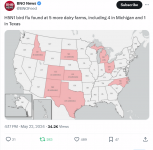You are using an out of date browser. It may not display this or other websites correctly.
You should upgrade or use an alternative browser.
You should upgrade or use an alternative browser.
HEALTH Bird flu that infected Texas man has mutated to spread more easily, CDC reveals —
- Thread starter jward
- Start date
jward
passin' thru
Ag commissioner says chickens destroyed to prevent bird flu spread being replaced
Erin Davis
3–4 minutes
TEXAS — Cows in the Texas panhandle tested positive for bird flu last month after thousands of livestock were killed in historic wildfires.
What You Need To Know
Bird flu struck about 40% of dairy cows in the Panhandle, where 82% of the state’s milk is produced
Experts say farmers should take certain biosecurity measures to protect their livestock from future cases
More than 1 million chickens were killed to prevent bird flu from spreading. Texas Agriculture Commissioner Sid Miller says they are easy to replace
One human contracted bird flu and experienced symptoms similar to pink eye. Experts say others aren’t at risk of being infected
The disease struck about 40% of dairy cows in the Panhandle, where 82% of the state’s milk is produced. Infected cows have stopped producing milk.
“The trick is, how do we return them back to their previous state of milk production?” said Darren Turley with the Association of Dairymen.
He says infected cows receive probiotics and electrolytes, but once a cow is no longer infected, it doesn’t always immediately resume milk production.
“If we have a cow that's not pregnant, and not giving any milk, it's very, very hard for us to make that work to keep that animal to pay for that animal,” Turley said.
Experts say farmers should take certain biosecurity measures to protect their livestock from future cases.
“Clean and disinfect those trucks coming on to your place. And the workers, too. If you have coveralls on at one dairy and that you’re not taking to other dairies, that would be of significant concern. And then if you’re a worker and dealing with sick cattle that they’re using personal protective equipment to ensure their safety as well,” said Dr. Brian Bohl, TAHC director of field operations.
Also in West Texas, more 1 million chickens were killed to prevent bird flu from spreading. Texas Agriculture Commissioner Sid Miller says they are easy to replace.
“We can have a new chicken hatched in 28 days. It doesn’t take that long. And that hen will be producing in less than six months from now. So once we get the birds disposed of, the house cleaned up, it'll be ready to restock and be back in business, you know, three to five months,” said Miller.
Miller says dairy and egg prices aren’t expected to increase and that the quality of the products is the same.
“We pasteurized most of the milk,” he said. “The only way you could get it is if [you're] drinking raw milk or unpasteurized dairy products. So if you want to be on the safe side, you might hold off on that for a while.”
One human contracted bird flu and experienced symptoms similar to pink eye. Experts say others aren’t at risk of being infected.
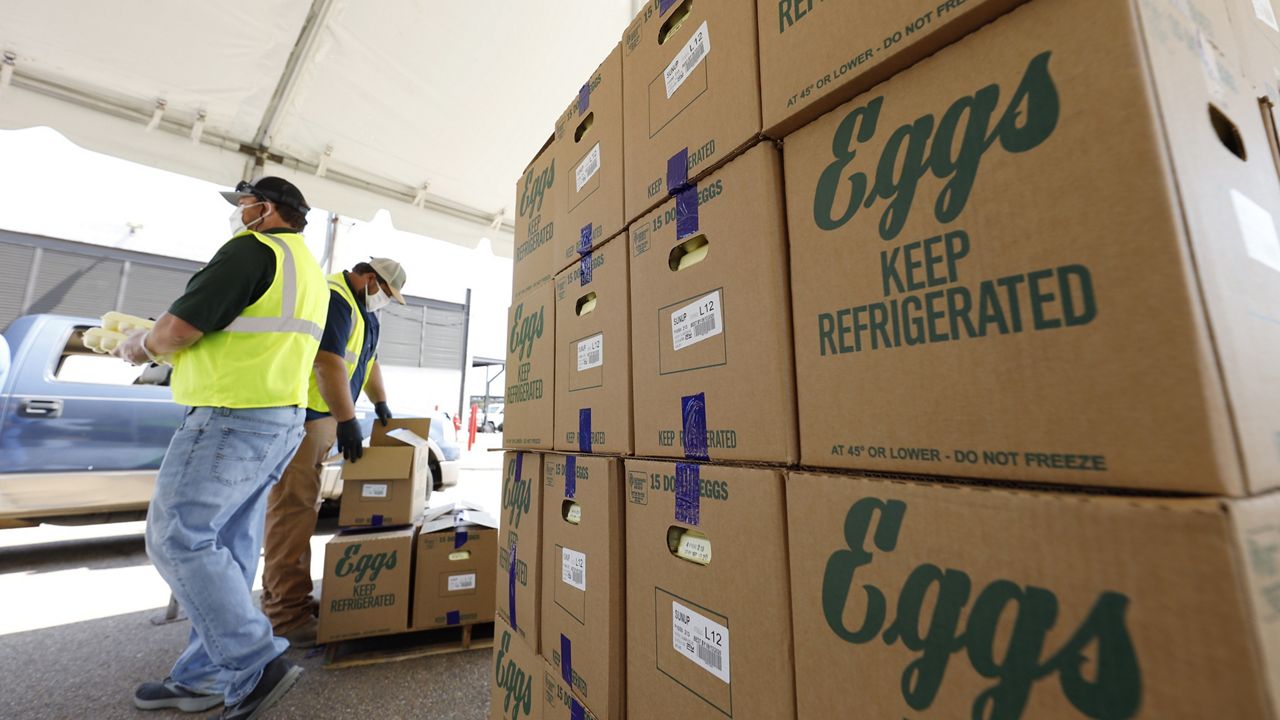
 spectrumlocalnews.com
spectrumlocalnews.com
Erin Davis
3–4 minutes
TEXAS — Cows in the Texas panhandle tested positive for bird flu last month after thousands of livestock were killed in historic wildfires.
What You Need To Know
Bird flu struck about 40% of dairy cows in the Panhandle, where 82% of the state’s milk is produced
Experts say farmers should take certain biosecurity measures to protect their livestock from future cases
More than 1 million chickens were killed to prevent bird flu from spreading. Texas Agriculture Commissioner Sid Miller says they are easy to replace
One human contracted bird flu and experienced symptoms similar to pink eye. Experts say others aren’t at risk of being infected
The disease struck about 40% of dairy cows in the Panhandle, where 82% of the state’s milk is produced. Infected cows have stopped producing milk.
“The trick is, how do we return them back to their previous state of milk production?” said Darren Turley with the Association of Dairymen.
He says infected cows receive probiotics and electrolytes, but once a cow is no longer infected, it doesn’t always immediately resume milk production.
“If we have a cow that's not pregnant, and not giving any milk, it's very, very hard for us to make that work to keep that animal to pay for that animal,” Turley said.
Experts say farmers should take certain biosecurity measures to protect their livestock from future cases.
“Clean and disinfect those trucks coming on to your place. And the workers, too. If you have coveralls on at one dairy and that you’re not taking to other dairies, that would be of significant concern. And then if you’re a worker and dealing with sick cattle that they’re using personal protective equipment to ensure their safety as well,” said Dr. Brian Bohl, TAHC director of field operations.
Also in West Texas, more 1 million chickens were killed to prevent bird flu from spreading. Texas Agriculture Commissioner Sid Miller says they are easy to replace.
“We can have a new chicken hatched in 28 days. It doesn’t take that long. And that hen will be producing in less than six months from now. So once we get the birds disposed of, the house cleaned up, it'll be ready to restock and be back in business, you know, three to five months,” said Miller.
Miller says dairy and egg prices aren’t expected to increase and that the quality of the products is the same.
“We pasteurized most of the milk,” he said. “The only way you could get it is if [you're] drinking raw milk or unpasteurized dairy products. So if you want to be on the safe side, you might hold off on that for a while.”
One human contracted bird flu and experienced symptoms similar to pink eye. Experts say others aren’t at risk of being infected.

Ag commissioner says chickens destroyed to prevent bird flu being replaced
The disease struck about 40% of dairy cows in the Panhandle
Infectious Disease Tracker
@HmpxvT
BREAKING:
H5N1 has affected about 40% of dairy cows in the Texas Panhandle, where 82% of the state’s milk is produced, according to Spectrum News.
5:11 PM · Apr 11, 2024
142.5K
Views
jward
passin' thru
FluTrackers.com
@FluTrackers
US - Gov. statement: "Highly Pathogenic Avian Influenza Detected in Three New Michigan Dairy Herds" (probable commercial herds) total known affected herds = 4 US - Dairy cows test positive for H5N1 avian flu in Texas, Kansas, Idaho, Michigan, New Mexico, Ohio, North Carolina, South Dakota - March 24+ One Texas human case April 1 - FluTrackers News and Information
h/t Treyfish #H5N1
3:29 PM · Apr 12, 2024
523
Views
@FluTrackers
US - Gov. statement: "Highly Pathogenic Avian Influenza Detected in Three New Michigan Dairy Herds" (probable commercial herds) total known affected herds = 4 US - Dairy cows test positive for H5N1 avian flu in Texas, Kansas, Idaho, Michigan, New Mexico, Ohio, North Carolina, South Dakota - March 24+ One Texas human case April 1 - FluTrackers News and Information
h/t Treyfish #H5N1
3:29 PM · Apr 12, 2024
523
Views
jward
passin' thru
FluTrackers.com
@FluTrackers
US - WOAH - #H5N1 avian flu in a wild mink in Bourbon county, Kentucky Kentucky - Avian flu in mammals - 2024 - FluTrackers News and Information
h/t Pathfinder
1:39 PM · Apr 12, 2024
1,543
Views
@FluTrackers
US - WOAH - #H5N1 avian flu in a wild mink in Bourbon county, Kentucky Kentucky - Avian flu in mammals - 2024 - FluTrackers News and Information
h/t Pathfinder
1:39 PM · Apr 12, 2024
1,543
Views
psychgirl
Has No Life - Lives on TB
Good Lord
Here we go.
jward
passin' thru
FluTrackers.com
@FluTrackers
Canada - WOAH: "We report additional cases of highly pathogenic avian influenza (HPAI) #H5N1 virus in skunks." (4 skunks in 3 different provinces) Canada - Outbreaks of highly pathogenic avian influenza H5N1 in non-poultry including wild birds (WOAH, June 29, 2023 -) - FluTrackers News and Information
h/t Pathfinder
6:40 PM · Apr 15, 2024
609
Views
@FluTrackers
Canada - WOAH: "We report additional cases of highly pathogenic avian influenza (HPAI) #H5N1 virus in skunks." (4 skunks in 3 different provinces) Canada - Outbreaks of highly pathogenic avian influenza H5N1 in non-poultry including wild birds (WOAH, June 29, 2023 -) - FluTrackers News and Information
h/t Pathfinder
6:40 PM · Apr 15, 2024
609
Views
jward
passin' thru
phys.org
Science X
4–5 minutes
 Credit: Pixabay/CC0 Public Domain
Credit: Pixabay/CC0 Public Domain
The case of a Florida bottlenose dolphin found with highly pathogenic avian influenza virus, or HPAIV—a discovery made by University of Florida researchers in collaboration with multiple other agencies and one of the first reports of a constantly growing list of mammals affected by this virus—has been published in Communications Biology.
The report documents the discovery, the first finding of HPAIV in a cetacean in North America, from the initial response by UF's Marine Animal Rescue team to a report of a distressed dolphin in Dixie County, Florida, to the subsequent identification of the virus from brain and tissue samples obtained in a postmortem examination.
Analyses initially performed at UF's zoological medicine diagnostic laboratory ruled out the presence of other potential agents at play in the dolphin's disease, with the Bronson Animal Disease Diagnostic Laboratory in Kissimmee, Florida, verifying the presence of HPAI virus in both the lung and brain.
Those results were confirmed by the National Veterinary Services Laboratory in Ames, Iowa, which characterized the virus subtype and pathotype. The virus was confirmed to be HPAI A (H5N1) virus of HA clade 2.3.4.4b. Subsequent tissue analysis was performed at the Biosafety Level 3 enhanced laboratory at St. Jude Children's Research Hospital in Memphis.
Allison Murawski, D.V.M., a former intern with UF's aquatic animal medicine program, was first author on the study and developed a case report on the dolphin as part of her research project. She traveled to Memphis and worked closely with Richard Webby, Ph.D., who directs the World Health Organization Collaborating Center for Studies on the Ecology of Influenza in Animals and Birds at St. Jude's and served as corresponding author on the paper
Webby's laboratory investigates avian influenza cases in many species and was key in determining where the virus may have originated, what unique RNA characteristics or mutations were present that could suggest its ability to infect other mammals, and how the virus could be tracked from this source.
The researchers sequenced the genomes from local birds and looked at viruses isolated from Northeast seal populations.
"We still don't know where the dolphin got the virus and more research needs to be done," Webby said.
"This investigation was an important step in understanding this virus and is a great example where happenstance joins with curiosity, having to answer the 'why' and then seeing how the multiple groups and expertise took this to a fantastic representation of collaborative excellence," said Mike Walsh, D.V.M., an associate professor of aquatic animal health, who served as Murawski's faculty mentor.
More information: Allison Murawski et al, Highly pathogenic avian influenza A(H5N1) virus in a common bottlenose dolphin (Tursiops truncatus) in Florida, Communications Biology (2024). DOI: 10.1038/s42003-024-06173-x
Citation: Florida dolphin found with highly pathogenic avian flu: Report (2024, April 26) retrieved 26 April 2024 from Florida dolphin found with highly pathogenic avian flu: Report
This document is subject to copyright. Apart from any fair dealing for the purpose of private study or research, no part may be reproduced without the written permission. The content is provided for information purposes only.
Florida dolphin found with highly pathogenic avian flu: Report
Florida dolphin found with highly pathogenic avian flu: Report
Science X
4–5 minutes

The case of a Florida bottlenose dolphin found with highly pathogenic avian influenza virus, or HPAIV—a discovery made by University of Florida researchers in collaboration with multiple other agencies and one of the first reports of a constantly growing list of mammals affected by this virus—has been published in Communications Biology.
The report documents the discovery, the first finding of HPAIV in a cetacean in North America, from the initial response by UF's Marine Animal Rescue team to a report of a distressed dolphin in Dixie County, Florida, to the subsequent identification of the virus from brain and tissue samples obtained in a postmortem examination.
Analyses initially performed at UF's zoological medicine diagnostic laboratory ruled out the presence of other potential agents at play in the dolphin's disease, with the Bronson Animal Disease Diagnostic Laboratory in Kissimmee, Florida, verifying the presence of HPAI virus in both the lung and brain.
Those results were confirmed by the National Veterinary Services Laboratory in Ames, Iowa, which characterized the virus subtype and pathotype. The virus was confirmed to be HPAI A (H5N1) virus of HA clade 2.3.4.4b. Subsequent tissue analysis was performed at the Biosafety Level 3 enhanced laboratory at St. Jude Children's Research Hospital in Memphis.
Allison Murawski, D.V.M., a former intern with UF's aquatic animal medicine program, was first author on the study and developed a case report on the dolphin as part of her research project. She traveled to Memphis and worked closely with Richard Webby, Ph.D., who directs the World Health Organization Collaborating Center for Studies on the Ecology of Influenza in Animals and Birds at St. Jude's and served as corresponding author on the paper
Webby's laboratory investigates avian influenza cases in many species and was key in determining where the virus may have originated, what unique RNA characteristics or mutations were present that could suggest its ability to infect other mammals, and how the virus could be tracked from this source.
The researchers sequenced the genomes from local birds and looked at viruses isolated from Northeast seal populations.
"We still don't know where the dolphin got the virus and more research needs to be done," Webby said.
"This investigation was an important step in understanding this virus and is a great example where happenstance joins with curiosity, having to answer the 'why' and then seeing how the multiple groups and expertise took this to a fantastic representation of collaborative excellence," said Mike Walsh, D.V.M., an associate professor of aquatic animal health, who served as Murawski's faculty mentor.
More information: Allison Murawski et al, Highly pathogenic avian influenza A(H5N1) virus in a common bottlenose dolphin (Tursiops truncatus) in Florida, Communications Biology (2024). DOI: 10.1038/s42003-024-06173-x
Citation: Florida dolphin found with highly pathogenic avian flu: Report (2024, April 26) retrieved 26 April 2024 from Florida dolphin found with highly pathogenic avian flu: Report
This document is subject to copyright. Apart from any fair dealing for the purpose of private study or research, no part may be reproduced without the written permission. The content is provided for information purposes only.
Florida dolphin found with highly pathogenic avian flu: Report
jward
passin' thru
1 in 5 US retail milk samples test positive for H5N1 avian flu fragments
Lisa Schnirring April 25, 2024
A senior official from the US Food and Drug Administration (FDA) said today that its nationwide survey of retail milk has found remnants of H5N1 avian flu viruses in one in five samples, with the highest concentrations in regions where outbreaks in dairy cattle have been reported.
Donald Prater, DVM, acting director of the FDA Center for Food Safety and Applied Nutrition (CFSAN), shared the new findings with state health officials who took part in a scientific symposium on H5N1 hosted by the Association of State and Territorial Health Officials (ASTHO). The results come in the wake of earlier findings this week from more limited FDA sampling, along with similar findings from a smaller set of samples tested by a lab that's part of the National Institute of Allergy and Infectious Diseases Centers of Excellence for Influenza Research and Response (CEIRR) Network.
At today's ASTHO briefing, state health officials heard the latest investigation and research updates from federal health officials and had the opportunity to ask their own questions, everything from virus shedding in cow manure to pandemic preparedness.
FDA's long list of research questions
Prater reiterated that the FDA hasn't changed its assessment that the nation's milk supply remains safe. So far, early work on milk samples that were positive for H5N1 fragments haven't found any viable (potentially infectious) virus.He said, however, that the FDA still has a long list of data gaps to fill, including identifying the risk of infection to humans via oral consumption and validating that existing pasteurization methods can inactivate H5N1.
Other data gaps include how long the virus survives in raw milk and the infectious dose of viruses. Though a major concern is retail milk, Prater also said the FDA needs to see if contamination is occurring in other products, such as cheese made from raw milk.
USDA continues to probe farm transmission patterns
Rosemary Sifford, DVM, deputy administrator for veterinary services and chief veterinarian with the US Department of Agriculture (USDA) Animal and Plant Health Inspection Service (APHIS) said the agency has now shared 260 genetic sequences with public databases, up from 239 earlier this week. Of those, only 1 had a mutation linked to mammalian adaptation.She also said the B3.13 genome circulating in cattle was first seen in poultry in the middle of March in a Texas flock at a time when the virus was cropping up in some of the state's dairy farms. Sifford said investigators continue to look at how the virus is moving on farms and how it transmits among cattle.
Scientists are looking for the virus in other species, including feral pigs, and regular influenza surveillance is monitoring the situation in commercial pigs. Sifford said efforts are under way to gauge how long infected cows shed the virus and if shedding patterns are any different in asymptomatic animals.
When asked about on-farm transmission, she said scientists haven't observed significant shedding in cow feces. Meanwhile, sampling from the USDA's Food Safety and Inspection Service (FSIS) found the highest concentrations in milk and mammary tissue.
CDC notes cat infections, weighs risks
Centers for Disease Control and Prevention (CDC) officials shared more details from their epidemiologic investigations, including virus findings in other animals on affected dairy farms. Sonja Olsen, PhD, associate director for preparedness and response with the CDC's Influenza Division, said there were 6 H5N1 positive tests in cats from three states: 3 in Texas, 2 in New Mexico, and 1 in Ohio.Also, there were 5 H5N1 detections in wild birds on the farms.
She said CDC a key question is the infection risk from exposure to milk and whether certain conditions, such as aerosolization, pose a higher risk.
Vivien Duggan, PhD, who heads the CDC's Influenza Division, said the interagency Flu Risk Management group, which formed 15 years ago, is meeting now to discuss prepandemic vaccines and diagnostics.
On the research front, the CDC is looking for any changes in the virus that would hamper the ability to use countermeasures, such as antiviral drugs and vaccines.
A key tool that the CDC uses to evaluate and prioritize resources is the Influenza Risk Assessment Tool (IRAT), in which its experts grade the virus using 10 data criteria. Duggan said the CDC is still gathering some data and that it will take some time to evaluate the virus and come up with a risk score. In its last assessment in July 2023, the agency scored the H5N1 clade 2.3.4.4b virus from a Spanish mink farm outbreak as slightly higher for some elements than a 2022 virus from the same clade from wild birds.
Latest on vaccines, other countermeasures
So far, research results have been promising for antiviral susceptibility. And for the two candidate vaccine viruses against the H5N1 2.3.4.4b clade, experiments using ferret antisera show good cross-reaction against the outbreak strain, she said.When state officials asked what would trigger ramped up H5N1 vaccine production, Duggan said officials are watching for certain cues, such as change in mammalian transmission, better adaptation to human-to-human spread, and clusters of cases. "There's no formula, but we're all on the watch."
Health officials also heard from government countermeasure experts, who said they don't foresee any issues with the antiviral supply chain.
State health officials had several questions about where things stand with a candidate vaccine. David Boucher, PhD, director of infectious disease preparedness and response at the Department of Health and Human Services Administration for Strategic Preparedness, said there is a limited quantity of prefilled syringes and vials that are used for clinical trials, for example. He added that health officials are already looking at regulatory pathways to use the vaccine more widely, if needed.
He said the first wave of production, if needed, could provide several hundreds of thousands of vaccine doses, and the second tranche could amount to 10 million doses. "Any pivot from that would require additional resources," Boucher said. "If we need to pull any of those levers, we're willing to do so."
Partnering with established seasonal flu vaccine producers has the benefit of a licensed platform in place that can be easily adapted to include an H5N1 vaccine virus, but he acknowledged that a downside would be a potential disruption in seasonal flu vaccine production. "There are a lot of variables that go into making that decision."
Two safety and immunogenicity studies are already under way on candidate H5N1 vaccines, Boucher told the group.
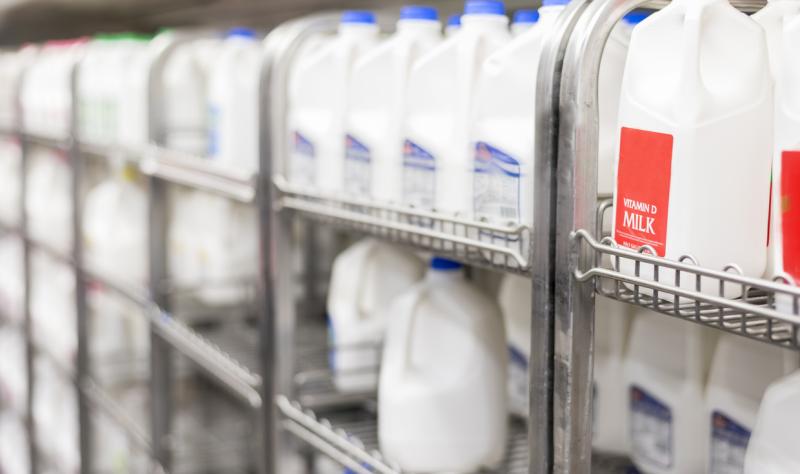
1 in 5 US retail milk samples test positive for H5N1 avian flu fragments
pauldingbabe
The Great Cat
Well damn! If it's that prolific we should be able to handle it. Right?
I mean 1 in 5 milk samples? Seriously, if this bug is that saturated in our food chain then everyone has been exposed and immunity should be taking hold.
I mean 1 in 5 milk samples? Seriously, if this bug is that saturated in our food chain then everyone has been exposed and immunity should be taking hold.
stop tyranny
Veteran Member
Maybe the title should read:
Lab engineered bird flu that infected Texas man successfully mutated to spread more easily, CDC reveals
desert_fox
Threadkiller
I am by one of the dairies that is affected here in Idaho. The other dairy's in the area have gone on total lockdown: every piece of equipment entering has to be washed and disinfected, essential personnel only. This includes milk transport trucks. The poor 4H kids who usually get their calf's from these places are SOL this year.
The initial outbreak came from cows that were recently shipped in the Texas but it has spread to two other dairy's in a two weeks time.
The initial outbreak came from cows that were recently shipped in the Texas but it has spread to two other dairy's in a two weeks time.
psychgirl
Has No Life - Lives on TB
I’m almost sure I’ve read you can’t catch it from eating the meat.
Or did I hallucinate that?
I fully understand the need for due diligence.The other dairy's in the area have gone on total lockdown: every piece of equipment entering has to be washed and disinfected, essential personnel only.
In my humble opinion they'll find songbirds or maybe even geese will be identified as the probable vector.
jward
passin' thru
Chris Turnbull
@EnemyInAState
Horrific outbreak of 'flu like illness' disease has killed a 19-year-old and seriously sickened many others in army outbreak as Covid continues to rampage and highly pathogenic bird flu takes off:
View: https://twitter.com/EnemyInAState/status/1785656823464284243
Chris Turnbull
@EnemyInAState
Outbreak happened on an Army barracks in Brazil: 77 are reported have symptoms, 24 hospitalised - a few one of them are so sick they are in ICU and one dead already:
View: https://twitter.com/EnemyInAState/status/1785657582511616131
@EnemyInAState
Horrific outbreak of 'flu like illness' disease has killed a 19-year-old and seriously sickened many others in army outbreak as Covid continues to rampage and highly pathogenic bird flu takes off:
View: https://twitter.com/EnemyInAState/status/1785656823464284243
Chris Turnbull
@EnemyInAState
Outbreak happened on an Army barracks in Brazil: 77 are reported have symptoms, 24 hospitalised - a few one of them are so sick they are in ICU and one dead already:
View: https://twitter.com/EnemyInAState/status/1785657582511616131
| lots more at his twitter thread. . .hmm. |
Tristan
TB Fanatic
Breitbart News
@BreitbartNews
Here it comes...
JDO Post
@JDOPost
1h
View: https://twitter.com/JDOPost/status/1777514833295909252
That's funny!
We don't even have the answers on CV-19, yet!

TheSearcher
Are you sure about that?
Covid continues to rampage? Where? I haven't heard of anyone in my circle catching it for many months, and my circle is not small.Chris Turnbull
@EnemyInAState
Horrific outbreak of 'flu like illness' disease has killed a 19-year-old and seriously sickened many others in army outbreak as Covid continues to rampage and highly pathogenic bird flu takes off:
View: https://twitter.com/EnemyInAState/status/1785656823464284243
Chris Turnbull
@EnemyInAState
Outbreak happened on an Army barracks in Brazil: 77 are reported have symptoms, 24 hospitalised - a few one of them are so sick they are in ICU and one dead already:
View: https://twitter.com/EnemyInAState/status/1785657582511616131
lots more at his twitter thread. . .hmm.
jward
passin' thru
and i have an untested house guest I've been nursing who's just now showing signs of recovering from it.
Anecdotal evidence is Almost as worthless as our governments LOL
Anecdotal evidence is Almost as worthless as our governments LOL
Covid continues to rampage? Where? I haven't heard of anyone in my circle catching it for many months, and my circle is not small.
So they found a way to get bird flu to mutate to mammals, surprisingly just before the election. This feels like a bad rerun. I know I will pull myself together and get through this if it happens, but I am just feeling so weak right now. I just don't want to do this again. It was a nightmare the last time. Isn't there anyone who will stop this evil?
jward
passin' thru
Culture War
@CultureWar2020
 "Is this Bird Flu just another election coming scam"......"We have credible evidence that's it's Gain of Function research AGAIN , being done in US laboratories Athens Georgia"
"Is this Bird Flu just another election coming scam"......"We have credible evidence that's it's Gain of Function research AGAIN , being done in US laboratories Athens Georgia"
Dr McCullough @P_McCulloughMD
John Fredericks @jfradioshow
 Follow & Smash Notification Check Highlights for more content like this
Follow & Smash Notification Check Highlights for more content like this
View: https://twitter.com/CultureWar2020/status/1793407467772141782
@CultureWar2020
Dr McCullough @P_McCulloughMD
John Fredericks @jfradioshow
View: https://twitter.com/CultureWar2020/status/1793407467772141782
jward
passin' thru
zerohedge.com
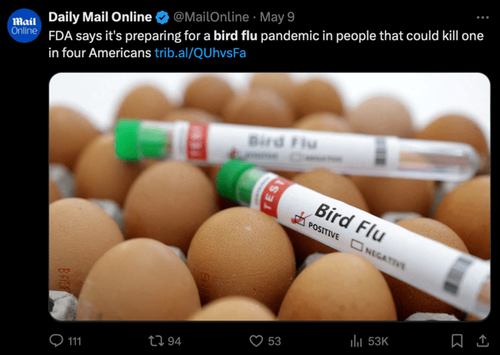
On the eve of the vote on the WHO’s Global Pandemic Treaty, FDA Commissioner Dr. Robert Califf issued a stark warning on capitol hill surrounding Bird Flu:
'This virus, like all viruses, is mutating,' he told the policymakers. 'We need to continue to prepare for the possibility that it might jump to humans.
[The] real worry is that it will jump to the human lungs where, when that has happened in other parts of the world... the mortality rate has been 25 percent.
We gotta have testing, gotta have anti-virals and we need to have a vaccine ready to go.”
Is the foreshadowing real?
The Chief Medical Board of The Wellness Company has been closely monitoring the avian flu (H5N1) outbreak in the United States over the last few weeks.
Dr. Peter McCullough points out that a mutated bird flu pandemic would serve several of the globalists’ goals and could be an imminent reality:
Bill Gates and the World Economic Forum (WEF) believe we should reduce our reliance on animal food products as part of their globalist views. Thus, a food scare in westernized countries with market recalls and destruction of poultry and meat would further dystopian goals for the Davos club.
H5N1 has a historical fatality rate of 52.16% in humans and fear alone could drive considerable anxiety in large populations not only about exposure through food, but pets, and other humans.
It's difficult to determine if H5N1 is the next ‘Disease X’ at the moment. It’s possible due to the abundance of gain-of-function research and biotech interests, ready-made vaccines, and powerful drivers of mass panic in the wings.
If more cases occur in clusters or bona fide outbreaks with human-to-human transmission, we could be well on our way to a 2024 avian influenza pandemic crisis.
As a precautionary measure towards a potential p(l)andemic, Dr. Peter McCullough and his colleagues on the Chief Medical Board elected to add Tamiflu to the Contagion Emergency Kit. The Kit, also containing ivermectin, hydroxychloroquine, z-pak and budesonide, is built to prepare the public to the greatest extent possible.
Dr. McCullough said:
“Out of an abundance of caution, we are adding Tamiflu to the Contagion Kit. Tamiflu is a safe medication approved treat Influenza type A, viruses like avian flu. We will continue to closely monitor this situation and make further recommendations as warranted.”
Oseltamivir (generic Tamiflu™) is an antiviral medication that disrupts replication of the Influenza A and B virus, including the avian ‘bird flu’ H5N1 variant to reduce the severity of flu symptoms.
Hope isn’t a strategy. Take steps today to prepare for the next crisis.
Now is not the time to panic, nor is it the time to be complacent – now is the time to be prepared.
Unlike 2020, we have the tools available to defend our health for whatever they throw at us next. And that’s where The Wellness Company comes in.
The Wellness Company and their new prescription Contagion Kits are the gold standard when it comes to keeping you safe and healthy.
Never be caught without these critical drugs in your medicine cabinet. Protect yourself and your family with The Wellness Company’s Contagion Kit before the next emergency hits!
The ultimate safeguard for your health.
Be ready for the next crisis. This Contagion Kit contains an assortment of life-saving medications – including ivermectin, and hydroxychloroquine. The Contagion Kit also includes a guidebook to aid in the safe use of these life-saving medications.
This kit is prescription-only – you can’t find it in any store. Simply fill out a short questionnaire after purchase and a trusted Wellness Company doctor will confirm your suitability and issue your prescription Contagion Kit.
The Wellness Company Contagion Kit contains:
This is the perfect emergency kit at the perfect price. Every home should have this for peace of mind. – Rebecca B.
This is absolutely great! I encourage everyone to buy one of these for emergencies!! – Melody H.
Peace of mind. It is an amazing peace of mind to have this kit in case of emergencies and shortages. The Wellness Company did an excellent job of getting this to me in a timely manner and I and thankful to have it. – Phyllis T.
Don’t be caught unprepared for whatever 2024 sends your way!
Order the Wellness Company’s Contagion Kit today!
 www.zerohedge.com
www.zerohedge.com

IT’S HERE: FDA Warns 25% Kill Rate in New Virus

On the eve of the vote on the WHO’s Global Pandemic Treaty, FDA Commissioner Dr. Robert Califf issued a stark warning on capitol hill surrounding Bird Flu:
'This virus, like all viruses, is mutating,' he told the policymakers. 'We need to continue to prepare for the possibility that it might jump to humans.
[The] real worry is that it will jump to the human lungs where, when that has happened in other parts of the world... the mortality rate has been 25 percent.
We gotta have testing, gotta have anti-virals and we need to have a vaccine ready to go.”
Is the foreshadowing real?
The Chief Medical Board of The Wellness Company has been closely monitoring the avian flu (H5N1) outbreak in the United States over the last few weeks.
Dr. Peter McCullough points out that a mutated bird flu pandemic would serve several of the globalists’ goals and could be an imminent reality:
Bill Gates and the World Economic Forum (WEF) believe we should reduce our reliance on animal food products as part of their globalist views. Thus, a food scare in westernized countries with market recalls and destruction of poultry and meat would further dystopian goals for the Davos club.
H5N1 has a historical fatality rate of 52.16% in humans and fear alone could drive considerable anxiety in large populations not only about exposure through food, but pets, and other humans.
It's difficult to determine if H5N1 is the next ‘Disease X’ at the moment. It’s possible due to the abundance of gain-of-function research and biotech interests, ready-made vaccines, and powerful drivers of mass panic in the wings.
If more cases occur in clusters or bona fide outbreaks with human-to-human transmission, we could be well on our way to a 2024 avian influenza pandemic crisis.
As a precautionary measure towards a potential p(l)andemic, Dr. Peter McCullough and his colleagues on the Chief Medical Board elected to add Tamiflu to the Contagion Emergency Kit. The Kit, also containing ivermectin, hydroxychloroquine, z-pak and budesonide, is built to prepare the public to the greatest extent possible.
Dr. McCullough said:
“Out of an abundance of caution, we are adding Tamiflu to the Contagion Kit. Tamiflu is a safe medication approved treat Influenza type A, viruses like avian flu. We will continue to closely monitor this situation and make further recommendations as warranted.”
Oseltamivir (generic Tamiflu™) is an antiviral medication that disrupts replication of the Influenza A and B virus, including the avian ‘bird flu’ H5N1 variant to reduce the severity of flu symptoms.
Hope isn’t a strategy. Take steps today to prepare for the next crisis.
Now is not the time to panic, nor is it the time to be complacent – now is the time to be prepared.
Unlike 2020, we have the tools available to defend our health for whatever they throw at us next. And that’s where The Wellness Company comes in.
The Wellness Company and their new prescription Contagion Kits are the gold standard when it comes to keeping you safe and healthy.
Never be caught without these critical drugs in your medicine cabinet. Protect yourself and your family with The Wellness Company’s Contagion Kit before the next emergency hits!
The ultimate safeguard for your health.
Be ready for the next crisis. This Contagion Kit contains an assortment of life-saving medications – including ivermectin, and hydroxychloroquine. The Contagion Kit also includes a guidebook to aid in the safe use of these life-saving medications.
This kit is prescription-only – you can’t find it in any store. Simply fill out a short questionnaire after purchase and a trusted Wellness Company doctor will confirm your suitability and issue your prescription Contagion Kit.
The Wellness Company Contagion Kit contains:
- Azithromycin (generic Z-Pak) 250 mg - 12 tablets
- Budesonide 0.5 mg/2 mL – 10 vials (plus nebulizer included)
- Hydroxychloroquine 200 mg -20 tablets
- Ivermectin 12mg – 25 tablets
- Oseltamivir 75 mg (generic Tamiflu™) - 10 tablets
- 1 Contagion Kit Guidebook written by the Chief Medical Board for safe use.
This is the perfect emergency kit at the perfect price. Every home should have this for peace of mind. – Rebecca B.
This is absolutely great! I encourage everyone to buy one of these for emergencies!! – Melody H.
Peace of mind. It is an amazing peace of mind to have this kit in case of emergencies and shortages. The Wellness Company did an excellent job of getting this to me in a timely manner and I and thankful to have it. – Phyllis T.
Don’t be caught unprepared for whatever 2024 sends your way!
Order the Wellness Company’s Contagion Kit today!
IT’S HERE: FDA Warns 25% Kill Rate in New Virus | ZeroHedge
ZeroHedge - On a long enough timeline, the survival rate for everyone drops to zero

jward
passin' thru
it failed, this time- but they're already hard at work revamping it so as to get it passed : (In a few days the globalist that be WHO are going to attempt to over ride our Constitution and put themselves in charge of our health using this turd flu excuse!
jward
passin' thru
Jim Ferguson
@JimFergusonUK
Breaking: Alert: Shocking leaked footage. H5N1 Pandemic is a go! Active preparations underway.
Leaked Footage Of Public Health Officials Discussing Enhanced Surveillance & Farm Quarantining For Avian Flu.
Make sure that you understand what is happening and get ready with thousands of like minded freedom loving people all around the planet.
Hop on board with the rest of us at our International Freedom Movement Inspiration Station and get your ticket to thrive and survive no matter what the globalist parasites try to do.
View: https://twitter.com/JimFergusonUK/status/1795374597883269339
@JimFergusonUK
Breaking: Alert: Shocking leaked footage. H5N1 Pandemic is a go! Active preparations underway.
Leaked Footage Of Public Health Officials Discussing Enhanced Surveillance & Farm Quarantining For Avian Flu.
Make sure that you understand what is happening and get ready with thousands of like minded freedom loving people all around the planet.
Hop on board with the rest of us at our International Freedom Movement Inspiration Station and get your ticket to thrive and survive no matter what the globalist parasites try to do.
View: https://twitter.com/JimFergusonUK/status/1795374597883269339
pauldingbabe
The Great Cat
Pride month affords a lot of travel for fun under the sun (gag).
Then you have all the Olympics stuff going on. Again a lot of people, a lot of travel.
Sounds like a perfect excuse to me.
Then you have all the Olympics stuff going on. Again a lot of people, a lot of travel.
Sounds like a perfect excuse to me.
SageRock
Veteran Member
Fair use cited.
 www.zerohedge.com
www.zerohedge.com
US 'Looking Closely' At Vaccinating Workers Exposed To Bird Flu: Official | ZeroHedge
WEDNESDAY, MAY 29, 2024 - 01:00 AM
Authored by Zachary Stieber via The Epoch Times (emphasis ours),
Officials in the United States, Canada, and Europe are considering the vaccination of workers and others against the highly pathogenic avian influenza.
The U.S. government is “looking closely” at the possibility of vaccinating farm workers and others in close contact with the virus, according to Dawn O'Connell, the assistant secretary for preparedness and response at the U.S. Administration for Strategic Preparedness and Response.
Angela Rasmussen, a virologist at the University of Saskatchewan, said she has been in discussions with U.S. and Canadian officials about using vaccines to protect workers after the influenza, or bird flu, jumped from birds to cattle.
The first cases of H5N1, a strain of the flu, in cattle were detected earlier this year, although some scientists say available evidence points to the cases cropping up in late 2023.
Discussions about using vaccines to try to prevent a pandemic are ongoing at the government level and among scientists in several places, including the UK, said Wendy Barclay, chair in influenza virology at University College London, who also researches avian flu for the UK Health Security Agency.
The UK government did not comment but said it is monitoring the situation in the United States.
In the European Union, the European Commission’s Health Emergency Preparedness and Response Authority is working on a joint procurement of CSL Seqirus’s vaccine to “potentially prevent a pandemic” sparked by individuals exposed to infected birds and animals, spokesman Stefan De Keersmaecker said.
A spokeswoman for CSL, which has contracts for pandemic influenza vaccines with 30 governments, said the company has been in talks with several governments about procuring vaccines since 2022.
The U.S. Food and Drug Administration approved a CSL influenza A vaccine in 2020, based largely on immunogenicity and safety results from a small clinical trial of 319 people.
Dr. Peter McCullough, an epidemiologist based in Texas, said on the social media platform X that without larger trials, it’s not possible to know whether the vaccine is safe or effective in humans.
The formulation for the CSL shot has been updated to more closely match the bird flu, which is an influenza A virus.
U.S. officials said recently that they’re planning to produce 4.8 million doses of the updated CSL vaccine. European health officials also said they were in talks to acquire CSL’s shot.
Canadian health officials said they have met with GSK, maker of Canada’s seasonal flu shots, to discuss acquiring and manufacturing a prepandemic bird flu vaccine.
The United States is in talks with Pfizer and Moderna, which make messenger ribonucleic acid (mRNA) COVID-19 vaccines, about potential pandemic vaccines.
University of Pennsylvania researchers said in a May 23 paper that their experimental mRNA bird flu vaccine performed well in preclinical testing in ferrets.
Since the bird flu cases in cattle were first detected, cases have been confirmed in 63 herds across nine states, including Colorado, Michigan, and South Dakota, according to the U.S. Department of Agriculture.
Richard Webby, a St. Jude Children’s Research Hospital virologist who studies flu in animals and birds for the World Health Organization, said the situation in dairy cattle merits vaccine use.
“If we look at the exposure levels that some of these farmers are getting, it’s high,” Mr. Webby said.
The decision on how and when to use the vaccine will hinge on evidence of increased transmission, severity of disease, cases in people with no link to a dairy farm, and mutations in the virus, U.S. Centers for Disease Control and Prevention (CDC) Principal Deputy Director Nirav Shah said.
The agency says on its website that the government is developing bird flu vaccines “in case they are needed.”
Human exposure to the virus in poultry and dairy operations could increase the risk that the virus will mutate and gain the ability to spread easily in people. Vaccines that perform poorly can also increase that risk.
So far, only one change has been detected in the human cases, the CDC said on May 24.
“These data indicate viruses detected in both cows and the two human cases maintain primarily avian genetic characteristics and lack changes that would make them better adapted to infect or transmit between humans,” the agency stated.
For now, CDC officials say the best way to avoid bird flu is to stay away from infected animals, fluids, and feces.
Workers who must come into contact with animals are advised to wear protective equipment and monitor themselves for symptoms, which include fatigue.
People who do become sick can take influenza antivirals, which are more effective when received shortly after symptoms develop.
Health officials also recommend cooking eggs and poultry to at least 165 degrees Fahrenheit, cooking beef to appropriate temperatures, and only consuming pasteurized milk.
Testing of beef found a surrogate virus was still present in burgers cooked rare, according to the Department of Agriculture. High levels of bird flu virus have been detected in raw milk. Some pasteurized samples tested positive, but further testing showed no viable virus, according to the Food and Drug Administration.
US 'Looking Closely' At Vaccinating Workers Exposed To Bird Flu: Official | ZeroHedge
ZeroHedge - On a long enough timeline, the survival rate for everyone drops to zero
US 'Looking Closely' At Vaccinating Workers Exposed To Bird Flu: Official | ZeroHedge
WEDNESDAY, MAY 29, 2024 - 01:00 AM
Authored by Zachary Stieber via The Epoch Times (emphasis ours),
Officials in the United States, Canada, and Europe are considering the vaccination of workers and others against the highly pathogenic avian influenza.
The U.S. government is “looking closely” at the possibility of vaccinating farm workers and others in close contact with the virus, according to Dawn O'Connell, the assistant secretary for preparedness and response at the U.S. Administration for Strategic Preparedness and Response.
Angela Rasmussen, a virologist at the University of Saskatchewan, said she has been in discussions with U.S. and Canadian officials about using vaccines to protect workers after the influenza, or bird flu, jumped from birds to cattle.
The first cases of H5N1, a strain of the flu, in cattle were detected earlier this year, although some scientists say available evidence points to the cases cropping up in late 2023.
Discussions about using vaccines to try to prevent a pandemic are ongoing at the government level and among scientists in several places, including the UK, said Wendy Barclay, chair in influenza virology at University College London, who also researches avian flu for the UK Health Security Agency.
The UK government did not comment but said it is monitoring the situation in the United States.
In the European Union, the European Commission’s Health Emergency Preparedness and Response Authority is working on a joint procurement of CSL Seqirus’s vaccine to “potentially prevent a pandemic” sparked by individuals exposed to infected birds and animals, spokesman Stefan De Keersmaecker said.
A spokeswoman for CSL, which has contracts for pandemic influenza vaccines with 30 governments, said the company has been in talks with several governments about procuring vaccines since 2022.
The U.S. Food and Drug Administration approved a CSL influenza A vaccine in 2020, based largely on immunogenicity and safety results from a small clinical trial of 319 people.
Dr. Peter McCullough, an epidemiologist based in Texas, said on the social media platform X that without larger trials, it’s not possible to know whether the vaccine is safe or effective in humans.
The formulation for the CSL shot has been updated to more closely match the bird flu, which is an influenza A virus.
U.S. officials said recently that they’re planning to produce 4.8 million doses of the updated CSL vaccine. European health officials also said they were in talks to acquire CSL’s shot.
Canadian health officials said they have met with GSK, maker of Canada’s seasonal flu shots, to discuss acquiring and manufacturing a prepandemic bird flu vaccine.
The United States is in talks with Pfizer and Moderna, which make messenger ribonucleic acid (mRNA) COVID-19 vaccines, about potential pandemic vaccines.
University of Pennsylvania researchers said in a May 23 paper that their experimental mRNA bird flu vaccine performed well in preclinical testing in ferrets.
Since the bird flu cases in cattle were first detected, cases have been confirmed in 63 herds across nine states, including Colorado, Michigan, and South Dakota, according to the U.S. Department of Agriculture.
Human cases
Two cases in humans—one in Michigan and one in Texas—have also been confirmed. Both have since recovered. Analysis of virus samples from the patients showed high similarities to the virus spreading in cows.Richard Webby, a St. Jude Children’s Research Hospital virologist who studies flu in animals and birds for the World Health Organization, said the situation in dairy cattle merits vaccine use.
“If we look at the exposure levels that some of these farmers are getting, it’s high,” Mr. Webby said.
The decision on how and when to use the vaccine will hinge on evidence of increased transmission, severity of disease, cases in people with no link to a dairy farm, and mutations in the virus, U.S. Centers for Disease Control and Prevention (CDC) Principal Deputy Director Nirav Shah said.
The agency says on its website that the government is developing bird flu vaccines “in case they are needed.”
Human exposure to the virus in poultry and dairy operations could increase the risk that the virus will mutate and gain the ability to spread easily in people. Vaccines that perform poorly can also increase that risk.
So far, only one change has been detected in the human cases, the CDC said on May 24.
“These data indicate viruses detected in both cows and the two human cases maintain primarily avian genetic characteristics and lack changes that would make them better adapted to infect or transmit between humans,” the agency stated.
For now, CDC officials say the best way to avoid bird flu is to stay away from infected animals, fluids, and feces.
Workers who must come into contact with animals are advised to wear protective equipment and monitor themselves for symptoms, which include fatigue.
People who do become sick can take influenza antivirals, which are more effective when received shortly after symptoms develop.
Health officials also recommend cooking eggs and poultry to at least 165 degrees Fahrenheit, cooking beef to appropriate temperatures, and only consuming pasteurized milk.
Testing of beef found a surrogate virus was still present in burgers cooked rare, according to the Department of Agriculture. High levels of bird flu virus have been detected in raw milk. Some pasteurized samples tested positive, but further testing showed no viable virus, according to the Food and Drug Administration.
Intestinal Fortitude
Have Faith
shhhh! (it's the Flying Fish)Seems to me that if it's also being found in dolphins that it is probably in other fish too. Tuna perhaps? Might want to skip the sushi bar....

